As our wood unit began, I started approaching plans for my design using what limited knowledge I already had about woodworking and wooden objects. I have always appreciated wood’s potential as a medium to produce works that serve both functional and aesthetic purposes, such as furniture or even the examples of reliquaries we examined in class. When analyzing wooden furniture or reliquaries, it becomes extremely apparent that, because of the availability of wood and its inherent material properties, the aesthetic principles of the artist or maker did not force them to compromise on the utilitarian quality of their work. I quickly began brainstorming a variety of ways to produce a container with a small block of wood. After all, how hard could it be?
However, our demonstration in the BeAM space gave me a much needed reality check. While only attempting to alter a small cube of wood at its surface level, I, within the span of an hour, learned how difficult it could be to make appealing designs with the wood burners and stabbed myself in the fingers with multiple chisels, multiple times. I quickly began to see that this assignment would literally demand my blood, sweat, and tears. After seeing the piece of wood we were given to work with, my awareness of a variety of limitations grew. While anticipating some inevitable mistakes, how could I use this small piece of wood to make a usable container? 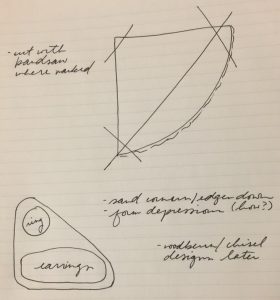 Moreover, how could I accomplish this task with a limited set of tools, limited time in and access to the BeAM space, and even fewer skills than I initially thought?
Moreover, how could I accomplish this task with a limited set of tools, limited time in and access to the BeAM space, and even fewer skills than I initially thought?
Thus, I began my process by drawing out a design. Seeing the limited amount of material I could work with and, therefore, my limited margin for error, I hoped that a hand drawn plan would help me to conserve as much time and wood as possible. My first step was understanding what I needed from the finished object to decide what I could demand from the piece of wood. In deciding to make a utilitarian object with some aesthetically pleasing elements, I was forced to reflect back on the aforementioned examples of wooden objects. When examining wooden furniture, the desks and chests and tables were produced for people who found use for them in their daily lives, within their given culture and time. I, therefore, determined that usefulness comes from an understanding of the habits and needs in the settings where the object would live.
I then turned to assessing my own habits to decide the best small-scale object to make. I have a terrible habit of taking off my jewelry and leaving it everywhere, much to the dismay of both my mother and my fiancé. I tend to leave it on the surfaces nearest my bed: the countertop of my sink and the top of a mini-fridge. On a daily basis, I wear my engagement ring and 3 pairs of earrings, as I have a lot of ear piercings. As a result, I decided to use my piece of wood to produce a usable jewelry dish with one small, circular depression designated for my engagement ring and a longer, more oblong trough for my earrings. I decided early in my design process that I wanted the dish to have a triangular shape with rounded corners, but that I would also be more improvisational with the wood burner and chisel as I knew that the form I was working with could easily and quickly change once the process began.
After completing the drawn design, it came time to begin the execution of my plan. The first thing I did after entering the woodshop at the Makerspace was use the 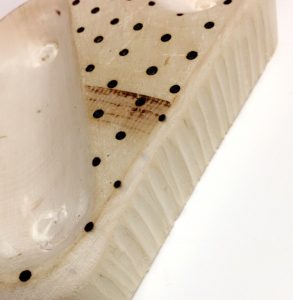 band saw to remove the bark side of the wood, then the extra wood at the three corners of the triangle, producing a shape not unlike the outline of the Superman symbol. I then used the power sander to round the corners and edges off, as well as smooth every other surface of the block. After my chiseling experience at the demo,
band saw to remove the bark side of the wood, then the extra wood at the three corners of the triangle, producing a shape not unlike the outline of the Superman symbol. I then used the power sander to round the corners and edges off, as well as smooth every other surface of the block. After my chiseling experience at the demo,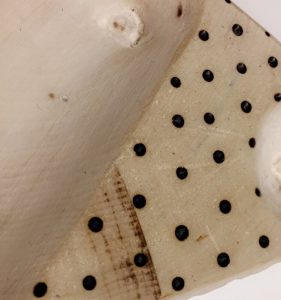 I elected to use a small chisel to incise a ridged design on the dish’s sides, moving in a downward motion that went with the grain for both ease and the safety of my fingers. I then changed the nib of the wood burner to a small, domed one to create an interlocking pattern of small polka dots on the surface of the dish.
I elected to use a small chisel to incise a ridged design on the dish’s sides, moving in a downward motion that went with the grain for both ease and the safety of my fingers. I then changed the nib of the wood burner to a small, domed one to create an interlocking pattern of small polka dots on the surface of the dish.
Then, it was time to begin making the depressions that would ultimately contain my jewelry. At first, I thought I could form the depressions using a chisel, but I quickly realized that the direction of the grain of the wood made this extremely difficult and time consuming work. Fortunately, Peri happened to be in the woodshop at the same time and, despite being hard at work on her own project, was kind enough to share the dremel power sander with me and show me how it was used. I then used the dremel to begin forming the depressions in the surface of my block, but quickly realized that even this was time consuming work that required command of the tool. I found myself sanding too deeply, and often too close to the edges of the block. Needing to give the dremel back to Peri, I resolved to hand-sand the depressions down to the desired depth. After two hours and stripping multiple pieces of sand paper, however, I was forced to accept how long it would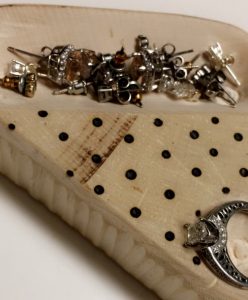 take to sand out the marks made by the dremel and I elected to leave them be, leaving me with my final product.
take to sand out the marks made by the dremel and I elected to leave them be, leaving me with my final product.
After this experience, I certainly have a new found appreciation for the skill of those who have mastered woodworking either as a hobby or a profession. Just trying to 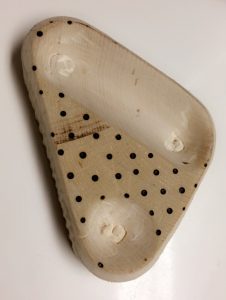 produce something as small as my dish made me conscious of the time, skill, and knowledge of tools, materials, and methods one must devote to mastering this material. Additionally, I became aware that woodworking demands understanding of how to adapt plans, because one must be fairly sure of the choices they are making in order to use the material without wasting it or having to seriously reduce its size to cover up errors. In the end, this experience was as rewarding as it was difficult, and I am very proud to have something both cute and functional that has become a part of my daily life.
produce something as small as my dish made me conscious of the time, skill, and knowledge of tools, materials, and methods one must devote to mastering this material. Additionally, I became aware that woodworking demands understanding of how to adapt plans, because one must be fairly sure of the choices they are making in order to use the material without wasting it or having to seriously reduce its size to cover up errors. In the end, this experience was as rewarding as it was difficult, and I am very proud to have something both cute and functional that has become a part of my daily life.